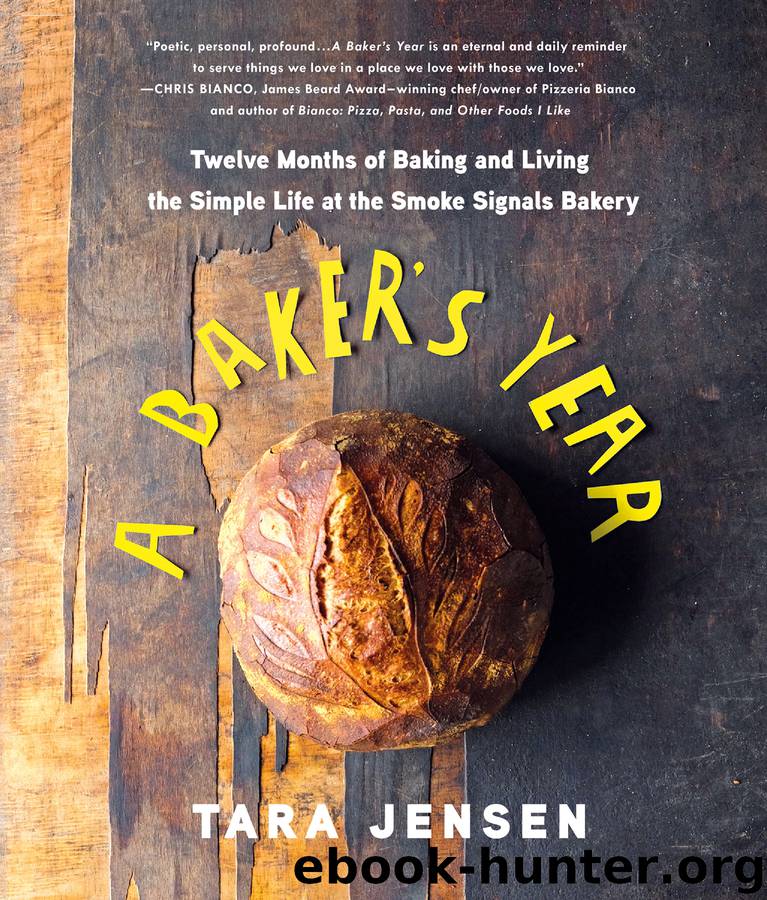A Baker's Year by Tara Jensen

Author:Tara Jensen
Language: eng
Format: epub
Publisher: St. Martin's Press
Published: 2018-01-11T05:00:00+00:00
HOW TO MAKE A PIE THE BEST WAY
Everyone wants to know how to make the flakiest pie crust, but the reality is that there are many different ways a light dough can be achieved and experienced. The texture of pie dough can range from mealy to flaky. Mealy dough has a lower percentage of liquid, holding up well against filling with substantial juices or eggs. Flaky dough puffs considerably and shatters when bitten. In the middle is a sandy-textured, crumbly crust. Each kind of dough has its place depending on the filling and amount of detail you wish to impart in any design work. Firm doughs support decorative aspects, holding shapes and clean lines. Flaky doughs make excellent free-form galettes and open-faced tarts. Regardless, when baked, a good crust should be golden, shiny, and deeply browned.
Flour.
Source flour with a protein content of 10 percent or lower. I choose the Carolina Ground type 75 pastry flour for a provincial taste or the Crema pastry flour, also from Carolina Ground, for a crisp texture. Both are made from a soft, red winter wheat. Start with cold flour. I store mine in the freezer.
Fat.
Every fat has a different melting point. Shortening is a favorite amongst pie bakers because it has a very high melting point. However, shortening and/or lard can leave off-putting flavors for sweet pies and a filmy feel in the mouth. Butter has a lower melting point, yet a pleasant, milky, grassy character. I use an all-butter recipe that has an 82 percent butterfat content. I like to order in bulk from the local co-op. If you feel adventurous, try 80 percent butter to 20 percent lard.
European-style butters have a higher percentage of butterfat and are considered cultured butters, which means that the cream is somewhat fermented. This imparts a distinctly “buttery” taste. In today’s butter, bacteria (Lactococcus and Leuconostoc) are introduced after the pasteurization process. The water in butter is released as steam while baking, giving pie dough a lift similar to puff pastry. Whatever butter you choose, be sure to keep it cold throughout the process so the water doesn’t leach out. I cube my butter beforehand and freeze it, starting the process with frozen butter. Since salt is added in with the dry ingredients, be sure to use unsalted butter in your crust. Salted butter can be overpowering in a dough, but if it’s all you have, go forward and simply omit the salt in the dry mix.
Water.
Water is both inside the butter and poured directly into the dough. If the butter is worked into the dry ingredients too much, water will separate out, soaking the flour, and a dough will form without the required amount of liquid. This results in a brittle dough due to lack of gluten development. If the butter is barely worked in when water is added, the dough will form too much gluten, making a tough and elastic crust that will shrink and snap. In general, use as little water as possible to bring the dough into a workable consistency.
Download
This site does not store any files on its server. We only index and link to content provided by other sites. Please contact the content providers to delete copyright contents if any and email us, we'll remove relevant links or contents immediately.
Ottolenghi Simple by Yotam Ottolenghi(3519)
BraveTart by Stella Parks(3397)
Trullo by Tim Siadatan(3382)
Bake with Anna Olson by Anna Olson(3358)
Harry Potter and the Prisoner of Azkaban (Book 3) by J. K. Rowling(3304)
Nigella Bites (Nigella Collection) by Nigella Lawson(3177)
Tom Kerridge's Dopamine Diet: My low-carb, stay-happy way to lose weight by Kerridge Tom(3066)
Best of Jane Grigson by Jane Grigson(2949)
Classic by Mary Berry(2947)
Solo Food by Janneke Vreugdenhil(2931)
Sweet by Ottolenghi Yotam & Goh Helen(2889)
Ottolenghi - The Cookbook by Yotam Ottolenghi(2872)
Flavor Flours by Alice Medrich(2815)
Coffee for One by KJ Fallon(2571)
Hot Sauce Nation by Denver Nicks(2451)
Veg by Jamie Oliver(2414)
Claridge's: The Cookbook by Nail Martyn & Erickson Meredith(2359)
Chefs & Company: 75 Top Chefs Share More Than 180 Recipes To Wow Last-Minute Guests by Isabella Maria(2006)
Lose Weight for Good by Tom Kerridge(1889)
